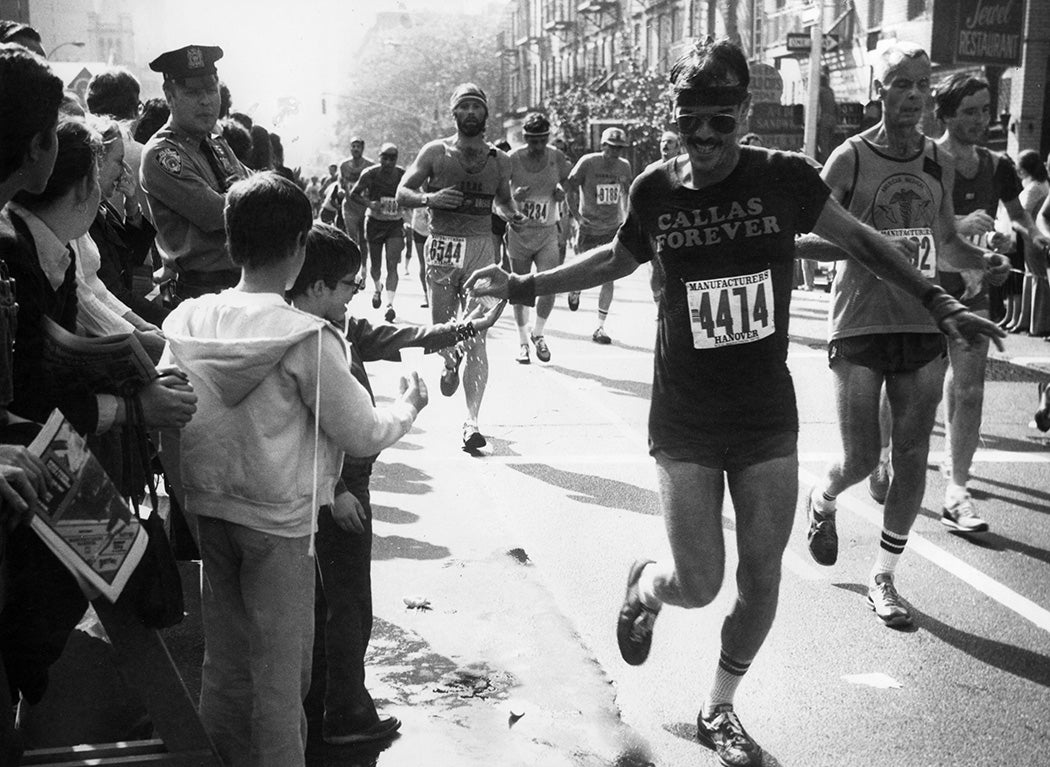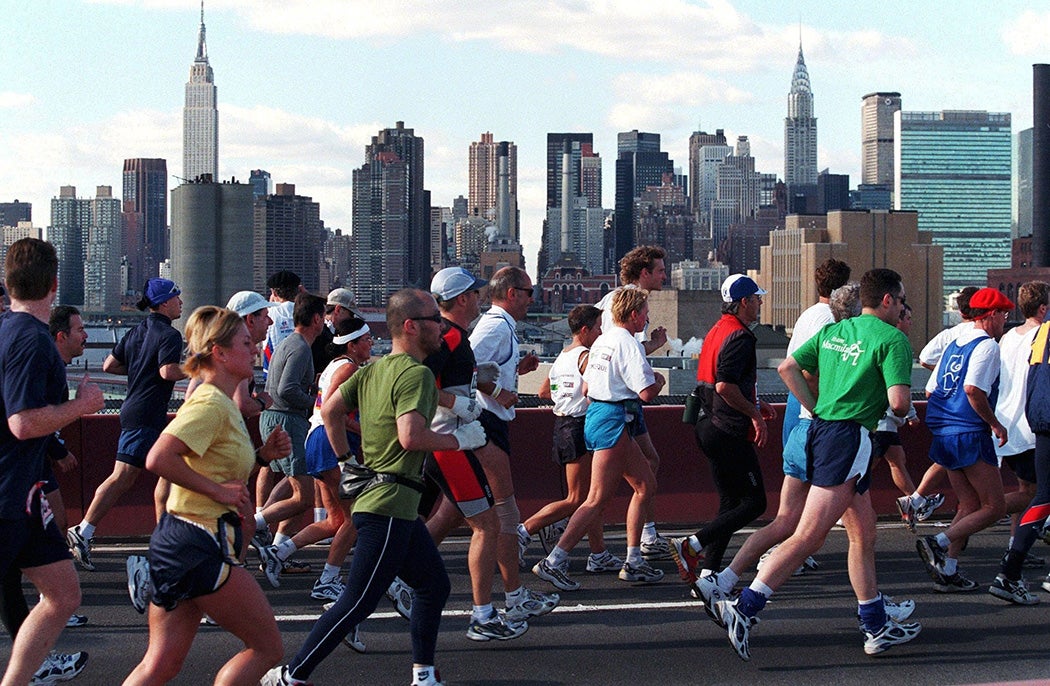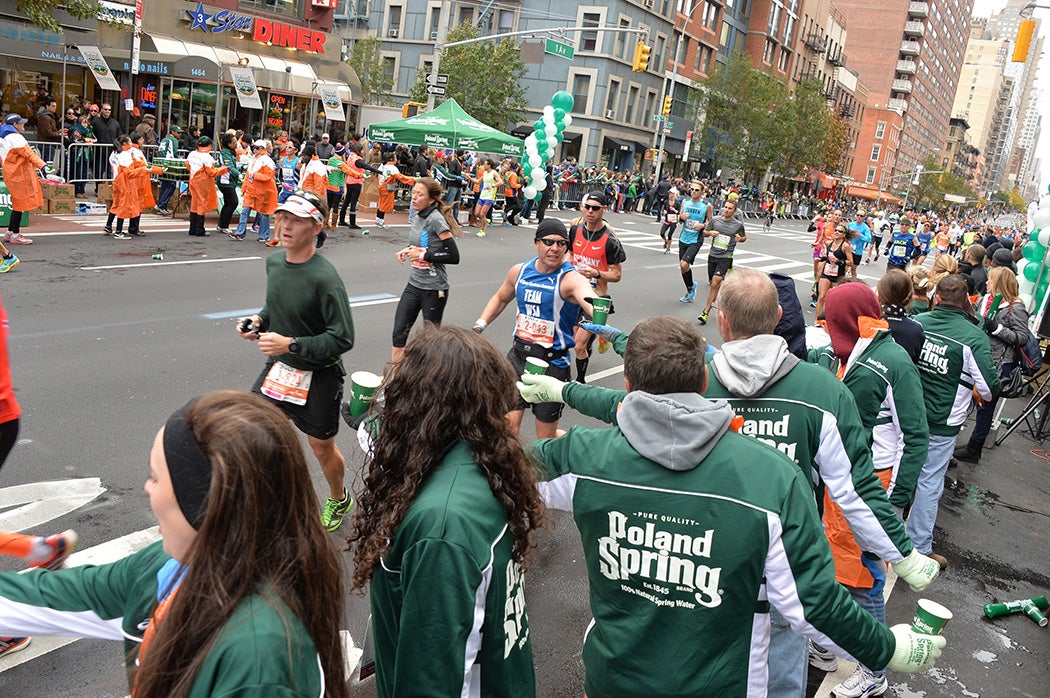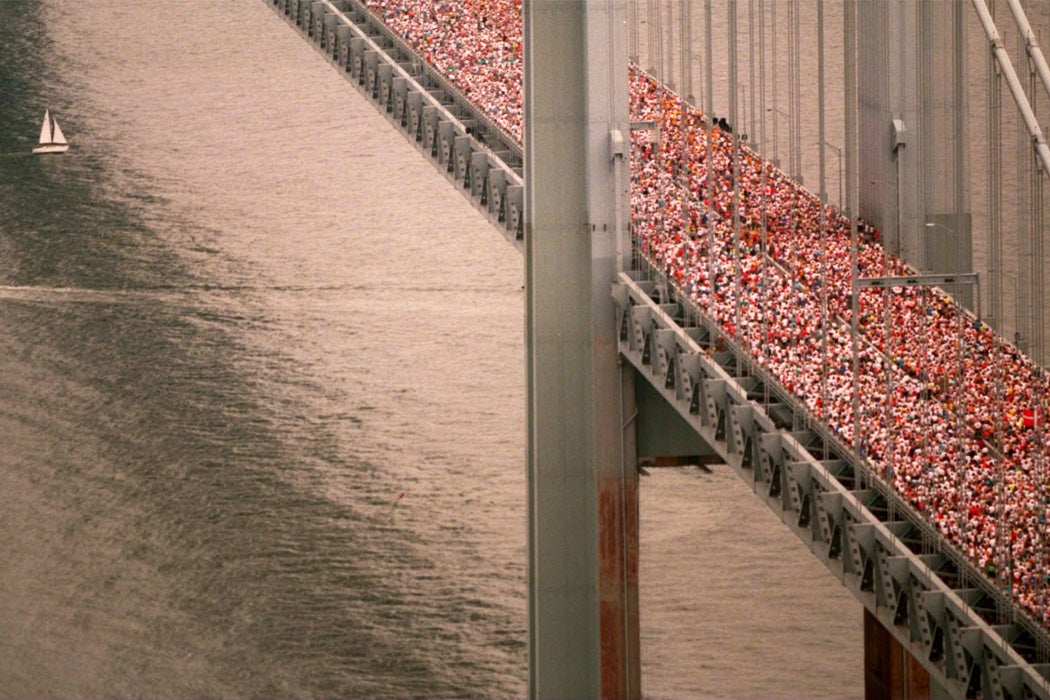On November 3, more than 50,000 people will line up to run the New York City Marathon. Of these, 40 will win prize money. Assuming the demographics are similar to the 2018 race, more than 22,000 will be women and almost 40,000 will have traveled from out of state for the race. When the race began at the beginning of the 1970s “running boom,” the typical entrant (who was male, all of them were) fit a now somewhat antiquated archetype of a stoic, solitary, working-class runner. Increasingly, though, the race is populated by a new demographic of runners: more recreational runner than aspiring contender, wealthier, and potentially female.
Among the most prominent characters of the old running archetype is Smith from Alan Sillitoe’s short story “The Loneliness of the Long Distance Runner.” Having been imprisoned for stealing bread, Smith begins running. He endures the lonely but welcome reprieve of miles in blazing heat and biting cold. When he shows talent as a runner, the wardens at Borstal are eager for him to race in the All-England race. Ultimately, in a move that has been seen alternately as “Christ-like” or “unrepentant,” Smith throws the race out of “disdain for the governor’s ambition.” Smith refuses to use his talent for running to be a model for his “class and kind.” Here, if running functions as a metaphor, it is as a metaphor for the suffering inherent in hard life.
Where Smith represents the old archetype, the new archetype is nearly the inverse. Running functions as a different metaphor entirely: one for our universal desire for and ability to achieve self-improvement. Characters like Brittany Forgler, the young woman who learns to love herself through training for the New York City Marathon in Brittany Runs a Marathon, are self-deprecating, full of doubt, and ultimately uninterested in their race times or place. Instead, she’s interested in the often appearance-driven self-improvement that running facilitates—and comes to represent. Likewise, in the real-life New York City Marathon, participants are increasingly entering expensive road races wearing carbon-plated shoes designed for professional marathoners and high-end GPS watches. Entrants are also more likely to identify as members of the professional class, seeking personal validation rather than competitive victory. While some of the changes to the race’s demographics—most obviously, the increasing participation of women in endurance sports and the creation of a wheelchair division with distinct awards—are undeniably positive, the race’s increased size and commercialization are both reflective of and responsive to broader changes in the culture of amateur distance running. And that culture feels increasingly responsive to—and responsible for—“wellness culture.”
Weekly Newsletter
Some of the changes specific to the New York City Marathon have happened at an institutional level. When Fred Lebow founded the marathon, in 1970, he was one of its 55 finishers. In the 22 years of his tenureship as race director, the race and its sponsoring organization, New York Road Runners, evolved from an event and organization appealing mostly to serious runners into the much larger, more broadly marketed and profitable, form they take today.
Writing in the Journal of Sport History, Pamela Cooper explains:
Before the “marathon boom” of the 1970s, marathoners were competitors who hoped, if not to win, at least place in the top ten or compete for age group awards. Marathon courses were often closed after four hours and the times of late finishers were unrecorded… New marathon runners often perceived the event less as a competition than as a ritual whose subjective reward was spiritual achievement.
Interestingly, Lebow himself finished that inaugural race 45th out of 55 runners, in 4:12, a time that even today would be considered average at best.
It’s not just the times of marathon entrants, though, that Cooper claims have changed. She highlights the sociological shift that has marked the sport as well: “when marathon fields were small, they comprised serious runners who were generally blue-collar men.” But as races like the New York City Marathon began to focus instead on drawing sponsorship and participation from more affluent runners, “the new upper-status runners were concerned with personal well-being.” In 1983, 90% of New York Road Runners members were college graduates.
By 1998, Vincent Serravallo, writing in the journal Race, Gender & Class, observed that just five professions represented an outsize number of participants: attorneys, physicians, engineers, managers, and educators. At this time, men still outnumbered women almost two to one. Serravallo breaks down the various ways in which marathon training and racing are expensive: the time required to log adequate miles in physical preparation, the additional cost of nutrient-dense healthy food preferred by many runners, and the gear (including the now humorously outdated “lyrca pants”) that many runners purchase. Serravallo’s breakdown includes late-90s prices (the cost of registering for the New York marathon alone has gone from $70 in 1998 to $255 in 2019, increasing at 2.5 times the inflation price), and it’s now common to see runners in, as mentioned, top-of-the-line GPS watches and lightweight carbon-plated shoes initially designed for professional athletes. The shoes often retail for $250.

Seravallo’s argument is that the limitations and positive reinforcement of class explain the disproportionate representation of wealthy marathon participants. For example, Seravallo points out that high-income earners are more likely to “enjoy the advantage of cleaner, safer, and more pleasant running provided by the residences their higher incomes can bring.” They have the kinds of higher positions within their jobs that allow for some flexibility (running at lunch time, or coming in early and logging more hours at home after a key long training run, for example), and the disposable income to buy the items and services he deems essential to appropriate training (clothing, shoes, access to a physical therapist for preventative care, or to a gym for strength training), and class culture. Seravallo is referring to class culture both in and outside of professional life, but there is doubtless significant overlap. A person who works with others who run recreationally or train for marathons is also more likely to encounter other runners and support for runners in their personal life. This notion of class culture gets at the dismantling of the working class running archetype and touches on the narrative of marathon running as a metaphor for personal improvement that Cooper attributes to Lebow’s leadership.
His New York Road Runners biography calls Lebow an “unlikely leader of the running revolution.” Perhaps this is why that metaphor of the marathon as personal improvement resonated. He emigrated to New York from Romania in the years after World War II and began running with the NYRR when it was still just an ad-hoc running club organized by its members. Under his leadership, the New York City Marathon began to pay professional runners and women began to compete. Lebow’s legacy is as much one of inclusivity as of entrepreneurial direction.
Even as women are increasingly involved in endurance sports, more than half of New York City Marathon competitors are still men. Serravallo attributes this continued disparity to gendered socialization, specifically in relation to the workload women take on outside of work and overrepresentation of women in fields like social work and kindergarten teaching, fields that lack a culture of support for marathon training. Seravallo observed that academics—mostly men—enjoyed a high level of professional and logistical support for training, while teachers at the elementary school level—mostly women—lacked both.

Still, the New York City Marathon saw its percentage of female participants increase exponentially during Lebow’s tenure. Doubtless much of this can be attributed to broader changes like Title IX, but Cooper argues that “women runners may have been the first to present the possibilities of the marathon as a profit-making experience.” The first women’s only race (a10-kilometer race in Central Park that’s still held today) that New York Road Runners hosted was the brainchild of a public relations firm. The model of sponsorship and marketing targeted at runners with disposable income that the marathon would ultimately adopt was rolled out at that inaugural women’s race. In 1978, the marathon distributed commemorative race t-shirts, which functioned as motivation, bragging rights, and of course, advertising for the race’s sponsors. Although it’s common now to see race t-shirts covered with multiple corporate logos, the Perrier emblem on the white and green ringer-t’s left sleeve was groundbreaking.
Writing for The Runner in 1978, Neil Amdur “made a connection between the new marathoners and the possibilities for corporate sponsorship” that capitalized on “changing the image of long-distance running from one of personal struggle to a joyous one shared by an entire city.” As the marathon grew in size and in visibility, the once scrappy, volunteer-run New York Road Runners became increasingly corporate, eventually paying Lebow and a growing staff. New York Road Runners certainly still depends on help from volunteers (up to 12,000 for the marathon alone), but it’s worth noting that these volunteers earn credit for their service toward a program that allows members who race nine New York Road Runners races and volunteer once guaranteed entry to the marathon the following year. The volunteers, like the runners, receive special t-shirts.
It’s hard to imagine Smith, the convicted criminal and gifted runner who throws his race in a refusal to acquiesce to the correctional facility, having or even wanting carbon-plated shoes, high tech watches, or a fleet of volunteers handing him Dixie cups of water. The type of runner Smith is meant to evoke (not necessarily criminal, but solitary, bitter, lean, hardened, and, of course, male) is so at odds with the wellness culture surrounding “bucket list” races like the New York City Marathon.

In “The Initiation of Alan Sillitoe’s Long-Distance Runner,” the scholar John Byars suggests that Smith’s decision to throw the race is a refusal of an archetypal hero’s initiation and instead a more complicated, if also heroic, journey, one that requires an understanding of the “interdependence of death and life.” This is a much darker, more frightening message than the often callow message of self-improvement begot through marathon training.
Cooper points out that “the association of running with such values as health, fitness, and feminism made marathoning attractive to upper-status individuals.” In this way, what happened with the New York City Marathon in the years after its inception seems a precursor to today’s behemoth wellness culture, or more generally, to the idea that self-improvement is synonymous with leading a meaningful life.
The solitary, even monotonous nature of long-distance running make it ripe for personal mythologizing. But, over the years, as it has grown in popularity, running has evolved from an unglamorous, inexpensive and accessible sport to one increasingly shaped by public relations firms and advertising dollars, precisely because of its universality and simplicity. Almost everyone has run at least a mile at some point. Understanding how races are scored is relatively uncomplicated. But even as distance running has become increasingly inclusive of women, it’s hard not to see something else that’s been lost. With the commercialization of distance running, the darkness inherent in the sport seems to have been stripped away in favor of more palatable, and, as a result, profitable, messaging. As the marathon has become increasingly lucrative, what it seems to represent in the popular imagination has morphed, becoming something a little more palatable for mass consumption.







